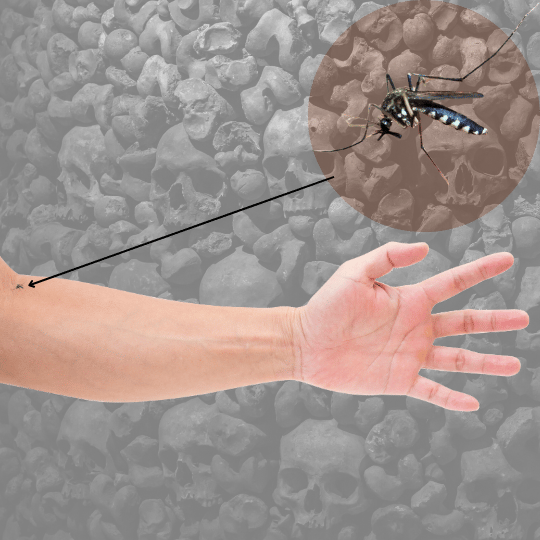My first encounter with Dengue fever was back in 1994 when a former bandmate contracted the virus. The funny thing is that we were told he had been enchanted by dwarves because the previous days, we were hanging out near an open canal that was said to house malignant mythical creatures.
Of course, being young, we immediately believed it.
The sad thing is that he wasn’t brought to the hospital until he had the obvious signs of dengue on him. He developed a red rash that seemed to take over his entire body, the crimson hue only broken up by tiny white spots, and he started bleeding from his gums.
When he was rushed to the hospital, the healthcare givers told his parents they brought him in just in time.
Fearing he’d die soon, I started visiting him frequently, bringing him comics and spending most of my after-school hours just hanging out with him while he suffered through the fever. We even joked about him getting a sponge bath from the nurse.
He had a catheter on so his lies about losing his V-card to the beautiful nurse was pretty obvious. I just didn’t let him know that I knew he was lying. He was probably scared of dying too young.
Since my family also owned a pharmacy, I would ask my dad for some help with the IV fluids. It was all I could do to help my friend then.
He survived that.
But the fear of contracting dengue stays with me to this day.
Dengue Fever in the Philippines
We have the fourth largest number of dengue fever cases worldwide. At 120 thousand cases annual average as of 2010, what we have is still a tenth of the country with the largest number of cases. And that country is Brazil. Which really spoils my plan of going there in the future.
No way am I going to a country that makes it ten times more likely for me to contract dengue than in my own country.
And Australia looks so much more attractive now since they’ve only had 13 cases since 2010. Ohhh crikey Oz, here I come.
After that initial dengue fever scare that I experienced in ’94, I really thought the disease had been eradicated. That’s because I didn’t hear much of it or was just too blind to notice its presence because I went through a period where I didn’t care much about anybody else but myself.
And to my surprise, it reared its ugly head back up again in 2019. Right before COVID crippled us all. In the Philippines, there were 150,000 cases reported with about 600 dead because of dengue.
Oh it was alarming and it made me very paranoid that I became obsessed about getting rid of potential breeding places near our home.
That paranoia has only increased since the birth of my son.
I am constantly trying to get rid of objects that could retain water and provide mosquitoes with a viable breeding ground.
What is Dengue Fever?
With all this talk about dengue fever, what do we really know about it?
Put simply, dengue fever is a disease one can get from a mosquito bite. The dengue virus, has become one of the worst mosquito-borne diseases in the last 20 years.
To date, there is no known cure yet.
How Do You Know if You Have Dengue Fever?
80% of people infected with the dengue virus rarely show signs or are asymptomatic. There may also be signs of slight fever. Only about 5% have more severe signs with a smaller proportion deemed as having a life threatening case of dengue fever.
Signs and symptoms of having dengue fever often show within a week of getting bit by a dengue virus carrying mosquito.
Detection
Dengue fever is easily confused with other diseases like chikungunya, malaria, typhoid fever, and Zika. This makes it extremely difficult to find it early and treat it accordingly.
A Dengue rapid test kit can be used to help with early detection. These test kits have a respectable accuracy for detecting viruses in our bodies.
Another way to do it would be to extract blood and have it tested in the lab for signs of infection.
Results often come from these tests within 24 to 48 hours.
Without testing, signs and symptoms of having the dengue fever may appear within 3 to 14 days after getting bit.
Mild Symptoms
- Headaches resembling a migraine or a tension headache usually felt behind the eyes.
- Joint pains
- Muscle pains
- Nausea
- Rash all over the body with white spots
- Swollen glands
- Vomiting
Severe Symptoms (Signs that You Have Dengue Hemorrhagic Fever)
- Bleeding from the nose
- Bleeding gums
- Blood in stool
- Blood in vomit
- Extreme thirst
- Fatigue or feelings of weakness
- Pale and cold skin
- Persistent vomiting
- Rapid breathing
- Restlessness
- Severe abdominal pain
Severe dengue can lead to internal bleeding, organ failure, shock and/or death.
Let’s Do Our Part in the Fight Against Dengue Fever
Since we have a high number of dengue cases it is only right that we should become proactive in fighting the disease. Dengue season is almost year round as it happens from June to February when the rainy season starts.
So, what can you do?
Thankfully, dengue fever is not contagious. And you only get it after getting bitten by a mosquito carrying the dengue virus.
It’s pretty obvious then that to combat the disease, we need to eradicate mosquitoes from our midst.
Keep Your Surroundings Clean
- And you can do this by keeping your surroundings clean and free from potential mosquito breeding sites.
- Don’t let water collect in old tires, bottles, plant saucers, or cans. Even something as small as a bottle cap can collect water and provide a mosquito enough space to lay their eggs in.
- Clear your roof gutters and drainage.
- Fix leaky faucets and pipes. The water coming from these can lead to puddles. And puddles and other standing bodies of water are attractive to mosquitoes.
- Cover all water containers.
Don’t Get Bitten
- Use mosquito repellent. They work.
- Use long sleeves and pants if you’re outside.
- Keep mosquitoes out of your house by installing window screens and using mosquito nets at night.
- Keep your house well-lit and ventilated. Mosquitoes are weak flyers. An electric fan will blow them away easily.
Show Them Mosquitoes That They’re Not Welcome in Your Place.
- Perform regular yard cleanup and cut tall grass and bushes. If there are coconut shells, remove them from your yard or use them to smoke mosquitoes out.
- Use mosquito coils (“katol”)all over your house or burn citronella leaves along with those empty coconut shells and other plant debris you collected.
- Create a light vinegar solution and spray around your home.
- Plant these: Citronella grass (“tanglad”), Marigolds, Lemongrass, Lavender, Neem tree, Basil (“balanoy”), Mint (“yerba buena”). Place them in strategic places. You can even make your house more aesthetically pleasing if you do some basic landscaping using any of those plants.
- Encourage natural predators to come visit your home. Bats and dragonflies are the mosquito’s natural enemies. Keeping fishes in open bodies of water takes care of the larva issue. It’s a win-win situation for you and nature if you take this route.
Make the Rest of the Community Pitch In
- Practice the 4 o’clock habit started by the Department of Health. This program seeks to encourage communities to clean their surroundings and eliminate potential breeding sites for mosquitoes at least every 4 o’clock daily.
- Apply larva killer to standing water if you can’t get rid of it. Otherwise, cover standing water with soil.
- Have community-initiated programs that seek to educate everyone about the dangers of dengue and mosquitoes. There should also be dengue testing kits ready if an outbreak occurs. Medical outreach programs or handing out mosquito nets also help.
- Last but not least, have regular fogging operations done. The community can contribute to pay for the services if there is no community fund from the government. Make sure to focus on the schools. Children are the most vulnerable demographic to dengue fever.
Together, We Can Fight Dengue
Prevention is better than cure and bringing in the entire community to join in on the effort to eradicate dengue is crucial. Always remain vigilant and be consistent in your efforts to put preventive measures in place.
The fight against dengue isn’t just for the rainy season.
Do it all-year-round.
We can do it.
Or in the immortal words of the dearly departed Senator Dr. Juan Flavier, “Let’s DOH it”
Send us an email with your suggestions on the next health topics we should cover.

